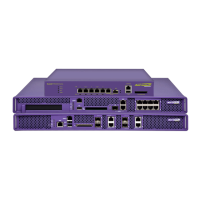Overview
Summit WM3000 Series Controller System Reference Guide20
Wireless Switching
The controller includes the following wireless switching features:
● Physical Layer Features
● Proxy-ARP
● HotSpot / IP Redirect
● IDM (Identity Driven Management)
● Voice Pri orit ization
● Wireless Capacity
● AP Load Balancing
● Wireless Roaming
● Power Save Polling
● QoS
● Wireless Layer 2 Switching
● Automatic Channel Selection
● WMM-UPSD
● Dynamic VLAN Support
Physical Layer Features
802.11a
● DFS Radar Avoidance – Dynamic Frequency Selection (DFS) is mandatory for WLAN equipment
intended to operate in the frequency bands 5150 MHz to 5350 MHz and 5470 MHz to 5725 MHz
when in countries of the EU.
The purpose of DFS is:
● Detect interference from other systems and avoid co-channeling with those systems (most notably
radar systems).
● Provide uniform spectrum loading across all devices.
This feature is enabled automatically when the country code indicates that DFS is required for at
least one of the frequency bands that are allowed in the country.
● TPC – Tra ns mi t P ow er Co nt rol (TPC) meets the regulatory requirement for maximum power and
mitigation for each channel. TPC functionality is enabled automatically for every AP that operates
on the channel.
802.11bg
● Dual mode b/g protection – (Effective Radiated Power) ERP builds on the payload data rates of 1 and 2
Mbit/s that use direct-sequence spread spectrum (DSSS) modulation and builds on the payload data
rates of 1, 2, 5.5, and 11 Mbit/s, that use DSSS, complementary code keying (CCK), and optional
packet binary convolutional coding (PBCC) modulations. ERP provides additional payload data rates
of 6, 9, 12, 18, 24, 36, 48, and 54 Mbit/s. The transmission and reception capability for 1, 2, 5.5, 11, 6,
12, and 24 Mbit/s data rates is mandatory.
Two additional optional ERP-PBCC modulation modes with payload data rates of 22 and 33 Mbit/s
are defined. An ERP-PBCC station may implement 22 Mbit/s alone or 22 and 33 Mbit/s. An optional
modulation mode (known as DSSS-OFDM) is also incorporated with payload data rates of 6, 9, 12,
18, 24, 36, 48, and 54 Mbit/s.

